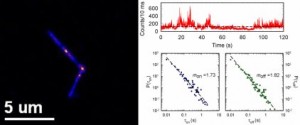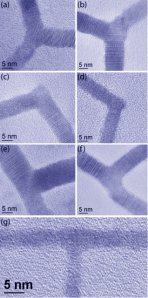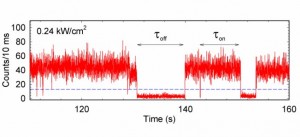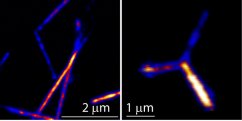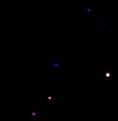httpv://www.youtube.com/watch?v=w6T6GPgQIQI
httpv://www.youtube.com/watch?v=5wmher9NMLk
Very few problems of early quantum mechanics remain unsolved today. Fluorescence intermittency is one exception. At the dawn of modern quantum mechanics, Niels Bohr predicted “quantum jumps” of electrons between discrete energy levels of atoms and molecules. Such jumps were observed directly only during the 1980s with the advent of single ion traps. An ongoing series of experiments brought spectacular progress to single molecule imaging, raising more questions than answers about these emission “jumps”.
Basically all known fluorophores studied to date exhibit fluorescence intermittency. They include single molecules, individual fluorescent proteins, polymer segments, semiconductor nanoparticles, nanorods and even nanowires. Such jumps, where the fluorophore literally stops emitting light under continuous excitation, are very different from those predicted by Bohr. Rather than occurring on the micro to millisecond timescales, they last seconds and even minutes. These experimentally observed off-times are vastly longer than any timescale one would retrieve from a standard quantum mechanical model. The “dark” states live practically forever. After these very long periods of darkness, the fluorophore eventually emerges into an emitting state. The new emissive state would be impossible if off periods were simply photobleaching events.
Even more intriguing are the statistics of the intermittency. Whereas Bohr would have postulated exponential distributions of “on”-times and “off”-times, universal power law on-time and off-time probability densities are actually observed. For colloidal quantum dots, this power law extends over an extraordinarily wide range that spans nine orders of magnitude in probability density and five to six orders of magnitude in time. This is remarkable for many reasons. First, the experimentally observed distribution refuses to yield a time scale. Second, universality on a lesser scale has revolutionized our understanding about phase transitions. Finally, such statistics arise from the behavior of single fluorophores, not an ensemble. Given that single organic molecules also blink and exhibit near-identical power law blinking kinetics, it is tempting to speculate that such striking similarity is not an accident. We therefore ask whether there exist unrecognized points of commonality between seemingly disparate entities such as molecules and semiconductor nanostructures. While the underlying mechanism for answering such questions remains a mystery, we argue in this perspective that many, if not all, key experiments have already been conducted and that substantial theoretical progress has been made.
The figures below show representative examples of blinking in quantum dots and nano-wires. An emission “trajectory” from both systems is provided, plotting emission intensity as a function of time. In both cases the intensity fluctuates. When a threshold is used to distinguish on- from off-states, second-to-minute long off-times are apparent.
Click on any of the six panels below for more details:
Below are static images and statistics of fluorescence intermittency for nanowires (click each image to see more detail):
Additional videos:
httpv://www.youtube.com/watch?v=JOH6iDu7HLw
httpv://www.youtube.com/watch?v=nDnppIdPEbI
httpv://www.youtube.com/watch?v=v_9uzz570yM
httpv://www.youtube.com/watch?v=p4y6zhaHrx0
httpv://www.youtube.com/watch?v=d-YwnBXZnj8








